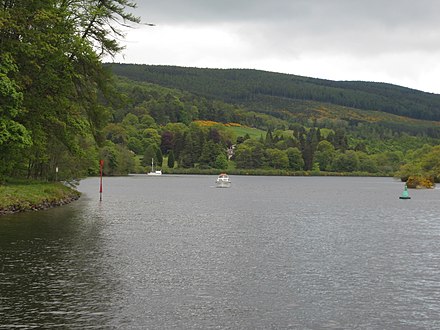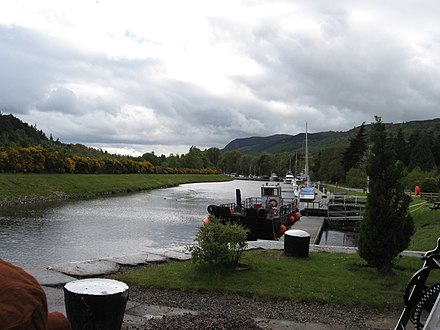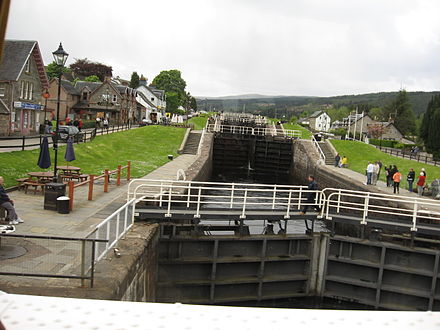Loch Ness - lake in Highland, Scotland, UK, outflows via Loch Dochfour to the River Ness and Caledonian Canal

The Great Glen is the deep diagonal fault line that runs across Scotland from Fort William in the south-west to Inverness in the north-east. The fault continues out to sea on both sides, as far as Shetland to the north and Clew Bay in Ireland to the west. It formed some 430 million years ago as the Caledonian mountains were thrust up, and remains active to this day. The fault movement shattered the granite, so that glaciers in later ice ages carved out a deep valley, which filled with rivers and lakes when the ice melted. Loch Ness is the longest and deepest of these, with Loch Oich and Loch Lochy further south. At its north end, Loch Ness is pinched into a narrow channel then widens again: this last section is called Loch Dochfour but it's the same body of water.
The Glen has long been a transport route through the Highlands. The first paved road was built by General Wade in the 1720s as a military route to keep the rebellious Highlanders in check. Nowadays this is the B862 & B852 running along the unpopulated east bank of Loch Ness. The modern main road is the A82, which runs along the west bank. The two roads combined make for a 70 mile (110 km) circuit of the loch.
The Caledonian Canal is a coast-to-coast channel, built by Thomas Telford in the early 19th C, that makes use of the string of lochs and rivers along the glen. Commercially and strategically it was obsolete as soon as it was completed in 1822, as shipping had outgrown it, and round-the-coast navigation was much safer since the end of the Napoleonic wars. It fell into disrepair but was rehabilitated for pleasure craft. Loch Ness, its centrepiece, is the magnificent natural channel that doesn't need maintenance, but there are ladders of lock-gates at each end that very much do. At the south end the canal and River Oich feed in from Loch Oich, the highest part of the system; at the north end, canal and River Ness flow down from Dochgarroch Weir towards the sea at Inverness.

Cities, towns and villages
See the entries below for details of transport, accommodation, eating & drinking, and sights & activities. This page is just about the loch itself.
- Inverness 📍 is six miles north of the loch. It's by far the largest town in the region, with the most visitor amenities, so it's the obvious base for touring the loch and Great Glen. It's also close to other sights such as Culloden, the Black Isle, Aviemore, Spey Valley and Cairngorms National Park.
- Along the east bank, via B852 & B862 the old military road, Dores is close enough to town to be commuterland, and has a couple of B&Bs and a pub, described under Inverness. There's basically nothing but scenery along the rest of the route, south through Inverfarigaig, Foyers and Whitebridge.
- Drumnadrochit is a small village on the A82 (west bank) but with hotels and facilities out of proportion to its size, thanks to "monster" tourism. The ruins of Urquhart Castle are two miles south at Strone point. The A831 branches west here into wild lonely hills towards Glen Affric and Cannich village, eventually looping north back towards Inverness.
- Invermoriston is an even smaller west-bank village where the River Moriston flows out into Loch Ness over a series of rapids. There's a couple of B&Bs and a camping & caravan site just south, and Alltsigh youth hostel two miles north, described under Fort Augustus. The A887 branches west up scenic Glenmoriston, eventually joining A87 to Kyle of Lochalsh and Skye.
- Fort Augustus is the village at the south end of the loch, where the canal begins its final climb up to Loch Oich. The fort, built in the 1730s, has variously been an abbey, a school, and a heritage centre, but is now an upmarket hotel.
- Fort William is 20 miles south of the loch, where the Great Glen enters the sea. So it's not the standard base for visitors but it has good transport and amenities, and is close to Ben Nevis, Glencoe, and routes to the Hebrides. With a car you can easily day-trip around Loch Ness from here.
Get in
By plane
Inverness Airport (IATA: INV) is 9 miles east of Inverness, off the A96 towards Nairn and Aberdeen. It has flights to Amsterdam, London (Heathrow, Gatwick and Luton) Bristol, Birmingham, Manchester, Kirkwall (Orkney), Sumburgh (Shetland), Benbecula (for N & S Uist) and Stornoway (Lewis).
Glasgow (IATA: GLA) and Edinburgh (IATA: EDI) have a better choice of flights across Europe, then it's a 3-hour drive north to reach the loch.
By train
Inverness has trains from Edinburgh, Glasgow, Perth, Aberdeen, London (King's Cross daytime, Euston for the Caledonian Sleeper), Kyle of Lochalsh for Skye, Ullapool for Stornoway on Lewis, and Thurso for Orkney.
Fort William has trains from Glasgow and another portion of the Caledonian Sleeper from London Euston. These trains also stop at Spean Bridge in the Great Glen and various middle-of-nowhere places up the Spean valley and across desolate Rannoch Moor. (You half-expect to see a Victorian ghillie in horse & trap awaiting, and the station for Brigadoon.) Fort William also has trains to Glenfinnan and Mallaig, for Skye and the Small Isles.
There is no railway along Loch Ness.
By bus
Inverness has buses every hour or so from Edinburgh and Glasgow via Perth and Aviemore. The main operators are Citylink, Parks of Hamilton and Megabus. There's an occasional through-bus from London Victoria.
Fort William has buses from Glasgow, Oban and Skye, plus summer services from Edinburgh, Perth, Kingussie and Aviemore.
Fort William and Inverness are linked by Citylink / Stagecoach Bus 919, four times M-Sat and two on Sundays. This runs along A82 via Spean Bridge, Laggan, Fort Augustus, Invermoriston and Drumnadrochit. It's a shared service, but each company only lists its own services, and there's no combined ticketing. This is no barrier to corporate guff about community transport partnerships.
Get around
You need a car. A bike might serve, but it's a long loch, the winds funnel along it, and A82 is busy with traffic.
Citylink / Stagecoach Bus 919 runs the length of the Great Glen and loch, see "Get in". At the north end it's supplemented by Bus 917 from Inverness to Portree on Skye: this follows the west bank via Drumnadrochit, Castle Urquhart and Invermoriston, before branching off on the A87 towards Kyle of Lochalsh. This runs twice daily.
Bus 16 runs along the northeast bank of Loch Ness from Inverness to Dores, Inverfarigaig and Foyers, four times M-F and twice on Saturday.
There was an attempt in 2005 to re-introduce the Loch Ness ferry, which plied between Fort Augustus and Inverness in Victorian times. It proved short-lived.
The Great Glen Way is a 79 mile footpath between Fort William and Inverness, west of the loch. There's both a high- and low-level route.
Nessie the Loch Ness Monster
Tales of water-monsters are as old as humanity. This particular beastie was first documented in the 6th C, when St Columba a century earlier was said to have encountered a man-eating monster in the River Ness. Having sent one of his followers into the river as bait while he himself craftily remained ashore, he made the sign of the cross, which scared it off for the next 1400 years.
It re-surfaced in 1933 / 34 with a rash of sightings, best-known being the "surgeon's photograph" published in the Daily Mail of 21 April 1934. The surgeon Mr Wilson was sufficiently embarrassed to try to keep his name out of the affair, and it was later exposed as a hoax: it was a toy submarine from Woolworths fitted with wood putty head, neck and fins, towed by a bit of string, and the photos were doctored.
From then on, Nessie was seldom out of fashion, generally depicted as a flippered plesiosaurus or three-humped serpent. There were photos, wide-eyed witnesses, spoofs, and mysterious sonar readings. There were scientific searches, blank or inconclusive: yet the creature's poop alone should have been visible from space. There were ding-bat theories and a dedicated investigation bureau. There were TV programmes and films, from the credulous to the sceptical: an example being the 2004 mockumentary Incident at Loch Ness by Werner Herzog and Zak Penn. But above all there was tourism. Nessie appeared on postcards, shortbread tins, calendars, cartoons, tea towels . . . and tourists flocked (and still flock) to the area, far more than would ever have been drawn by the area's natural beauties. Many people along the loch depend economically upon Nessie; it's surely done more to boost the area that any conventional regeneration / development project.
None of that could have happened if Nessie didn't somehow feed a basic human desire for mysteries and folk tales. So the answer to the long-standing question "Where's Nessie?" is that somehow he / she / it is within every one of us; and we need Nessie more than it needs us.
See
-
Urquhart Castle, 57.324°, -4.442°. Impressive ruins from the 13th-16th century on a headland overlooking Loch Ness two miles south of Drumnadrochit. 2022-08-11
-
Loch Ness Exhibitions in Drumnadrochit: the Loch Ness Centre covers the natural science of the loch, while Nessieland is the theme-park version.
-
Caledonian Canal. Stretches 60 miles from Corpach on Loch Linnhe west of Fort William to the Moray Firth at Inverness. Several ladders of locks carry the canal up the gradient to Loch Oich: the four Muirtown locks at Inverness Marina at the north terminus of the canal, the five Fort Augustus locks at the south end of Loch Ness, and the eight Banavie locks ("Neptune's Staircase") above Corpach at the southern terminus. The maximum boat length that can be accommodated is 150 ft (45.72 m) and the maximum beam is 35 ft (10.7 m). 2022-08-11
Do
- Boat trips venture out onto the loch from Fort Augustus, Drumnadrochit and Inverness - the latter may include a town centre pick-up, or you may need to make your own way to the jetty.
- Cruise Loch Ness, Fort Augustus PH32 4BD (At canal swing bridge), +44 1320 366277. Daily throughout the year. Boat cruises by standard boat or bouncy Rib. From £14 for a one-hour trip 2018-12-13
- Castle Cruises, Temple Pier West, Drumnadrochit IV63 6XR, +44 1456 450695. April-Oct daily. Boat cruises around the castle. From £14 for a one-hour trip 2018-12-13
- Jacobite Cruises, Tomnahurich Bridge, Glenurquhart Road, Inverness IV3 5TD (Off A82 near Botanic Gardens), +44 1463 233999. Daily throughout the year. Various Inverness-based tours and cruises on and around Loch Ness and the Caledonian Canal. From £14 for a one-hour trip 2018-12-13
- Go hiking. Loch Ness is a very popular area for walkers (see walkhighlands.co.uk for detailed hiking suggestions). The Great Glen Way traverses the length of the loch's west bank, passing through all the main villages.
Stay safe
Usual advice applies about Scottish weather - it doesn't have to be winter to be rough - and never underestimate Loch Ness. It's a long, deep, cold lake perfectly aligned with the prevailing south-westerly winds, so there can be an hefty "fetch" on the water with big waves. Swimmers, it's cold out there and it's fresh water, so you're not as buoyant as in the sea.
Go next
The choice is north to Inverness, thence towards Aberdeenshire, Aviemore, Black Isle and Ross & Cromarty; east via Spean valley to the Tay valley and Perth; south to Fort William and Oban; or west to Skye.


